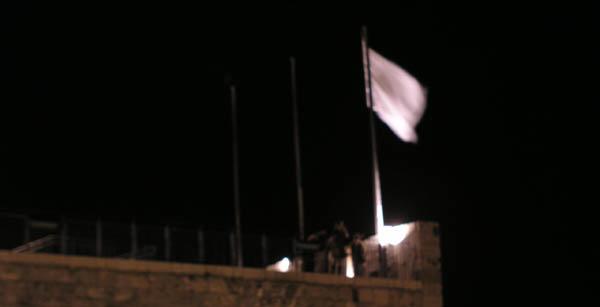Heara 6 - On the Borders (of) the Comment
Oct 23 2003
The Tower of David Fortress
David’s Tower Rediscovered (fragment)
Rene Sivan
The Tower of David Museum Publications
January 01 1993

The Citadel
Since the second century B.C.E, the area of the citadel, that used to be one of the strategically weakest spots of the city- was fortified by all the rulers of Jerusalem- each ruler adding to what his predecessors had built. The first to leave their mark on the Citadel were the Hasmonean Kings. Herod, who was king of Judea in the first century B.C.E. added three prominent towers. One of those towers has survived and still stands. It is this tower, which was called in popular tradition “the Tower of David”. In the Roman Period the area was used as a camp for Roman soldiers. The Moslems, after their conquest of Jerusalem in 638 C.E. built a citadel in the area. Under, the Crusaders (1099) the Citadel continued to fulfill its traditional military function, and a new structure enclosing the Herodian tower was built during that period. In the 13th century, the citadel was to be destroyed again, by the ruler of Kerak, descendant of Saladin. It remained in ruins until the 14th century when the Mamelukes rebuilt it, giving the Citadel the same basic shape it has today .
The Citadel enjoyed further architectural improvements during the Ottoman rule (1517-1917). They built the minaret, which since 19th century has been regarded as representing
Tower of David, and later on, Jerusalem itself. In 1917, the British army entered Jerusalem, and the fortress is converted into a museum and a cultural center, where exhibitions and concerts were held.
In 1947 the Citadel is reverted to its original role-i.e. a military stronghold, this time for the Jordanian Army. After Six Day War, in 1967, now under the rule of Israel, the Citadel is destined to be a cultural center.
“The Tower of David- Name and Symbol”
Various excavations have shown that The Citadel has no connection, historically, with King David.
The Byzantines in the 4th century C.E. appellate erroneously one of the Herodian towers as
Tower of David.The Moslems who conquered Jerusalem in the 7th century, like the Byzantes before, also associated the Herodian tower with King David. They called “Mihrab Nabi Da’ud”- “Mosque of the prophet David”.
In the 19th century a far- reaching change takes place in graphic representations of the Tower of David. Travellers and research scholars approaching the city from the west were impressed by the minaret of the mosque built during the 17th century at the southwest corner of the Citadel. Thereupon the name is transferred from the Herodian tower to the relatively recent Turkish minaret, as can be seen from engravings illustrating the books these travelers have published. Thus the Moslem minaret became the visual symbol of the Tower of David.With the stablishment of “Bezalel” in 1906 the “Tower of David” acquired the status of a national symbol.This found expression in the abundance of souvenirs and religious artifacts created in the school’s workshops. After the Six Day War it acquired a new significance, it became in the symbol of the city of Jerusalem.
The Citadel as a place for art exhibitions and as a museum
Between the years 1922-1927, (during the British mandate), several inividual shows and groups exhibits were held. While in the early exhibits the participants were mainly Bezalel teachers (Boris Shatz, Abel Pann, Gur Arieh, Raban, Ben Dov and others), the later exhibits included younger artists, mostrly Bezalal students, who rebelled against the Bezalel style and began to achieve prominence (Reuven, Gutman, Zaritsky, Malinkov, etc).
In the early forties- the Palestine Folk museum was established in the Citadel. The museum was founded in 1935 by a group of residents of Jerusalem, British, Arabs and Jews, interested in the preservation of examples of the indigenous arts and crafts from Palestine.
The Permanent exhibition
Museum “Migdal David” relates the story of Jerusalem along its 4000 years, from the Cananite period till 1948. The permanent exhibition, remarks the central events in each period and the importance of Jerusalem for the three big monotheistic religions: Judaism, Islamism and Christianity.
